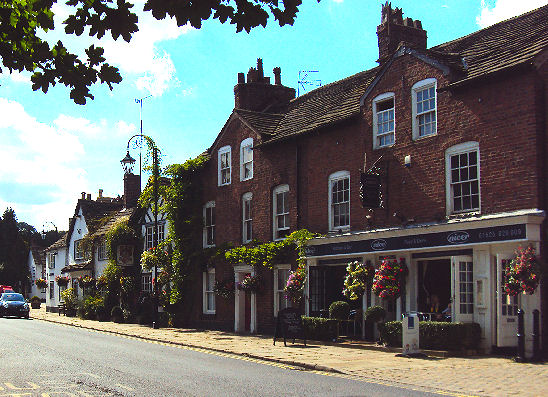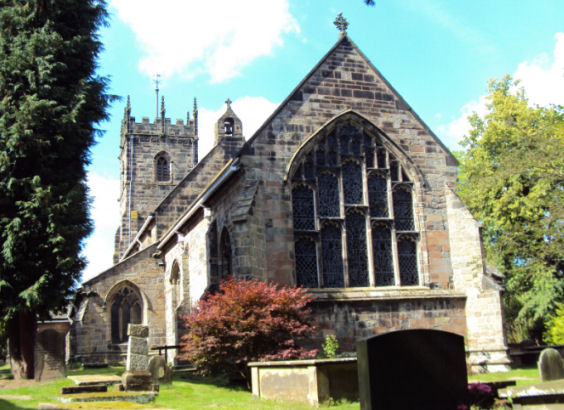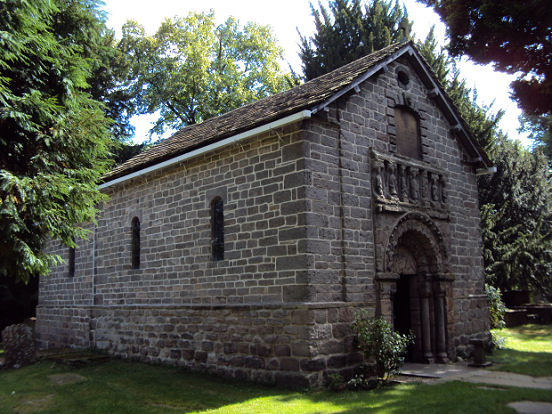Prestbury
OS Grid ref:- SJ8977
The attractive village of Prestbury clusters around its sandstone church and lies around one and a half miles (3km) from Macclesfield. The name derives from PreŰsta burh, which is sometimes thought to mean priests' town, but more correctly means a priests' fortified enclosure.

The village is pleasantly situated on the banks of the River Bollin and extends along the Bollin valley towards Wilmslow. The main street sweeps down to a bridge over the river and is lined with restaurants and shops, many of them antique shops, the old paving and cobbling which is retained throughout village is a very attractive feature. Prestbury is a frequent winner of Best Kept Village/Community Pride Competitions.
Prestbury Hall stands in the main street, constructed by the wealthy local Sutton family and dating to the early fifteenth century, the hall was restored in the Georgian era. It has small-panel wooden sash windows, a plastered front and elegant Adam style withdrawing rooms on a half-circular plan were added to the garden side.

Prestbury contains an assortment of timber-framed Tudor buildings, acclaimed restaurants and historic pubs. The half timbered Priests House, which dates from the 1580's, now serves as the village branch of the Natwest bank. Above the entrance to the building is a gallery from where the village parson, ejected from his church by the Commonwealth, used to preach to the assembled villagers. Local tradition states that there was once a secret passageway to St. Peterís Church across the street. In the twentieth century the building was carefully restored for use as a bank it boasts an oak beamed ceiling and a stone-flagged floor. The original glass in the leaded lights has the tints of green and rose similar to those of Haddon Hall.
Also of interest is the Reading Room, which dates to 1720. Brooks Cottages are marked with a plaque reading "Rodger Brooks and Ellen his wife erected this house in the 24 years of his life Ano Dom 1686". The Legh Arms, an Elizabethan building, probably dates from around 1580, and was originally called the Saracen’s Head after the crest of Sir Brian Stapleton of Upton who had followed Edward I in the Crusade of 1270. The Bridge Hotel, which is situated by the river, was once a farm and dates from 1626.
During the twentieth century Prestbury developed into a much sought after residential area with a reputation for affluence. The village contains many restaurants, pubs and bistro's.
St. Peter's church
The parish church of St Peter, dates from the thirteenth century but was restored in 1879 by Sir George Gilbert Scott. The church was commenced about 1220, with the building of the chancel in the Early English Gothic style. It belonged to the Abbey of St Werburgh in Chester until the Dissolution of the Monasteries in 1448.
St. Peter's contains a magnificent eighteenth century screen of carved oak which was erected in 1740 for the Legh Chapel, the royal coat of arms of the House of Hanover has been displayed on the screen since 1787. The ringersí gallery above the porch dates to 1637 and was formerly an organ loft. Ancient candle brackets remain on the pillars and the south wall.

The pulpit is Jacobean (1607) and was discovered in 1858 encased in a three-decker pulpit which had been made in 1710. The oldest monument in the building is a memorial slab built into the north wall dating to 1482. It commemorates Reginald Legh who helped to build the tower and south porch. The oldest piece of glass in the church is the small figure of St Nicholas at the top of the east window of the south aisle, it dates to the fourteenth century. The font dates from the thirteenth century but was refaced and recut in 1857. The Tytherington Chantry Chapel, dedicated to St Nicholas, was built in 1350 it contains a fourteenth century piscina with a carved head.
The churchyard contains a Norman chapel and an ancient Saxon Cross. The fragments of the Saxon Cross was found embedded in the walls of the chancel in 1840, where it had lay hidden for centuries. They are purported to date from the tenth or eleventh century.
The Norman chapel in the churchyard

The Norman chapel is a simple stone building dating to the twelfth century, it replaced an earlier Saxon timber building which once occupied the site. It possesses a beautiful Norman doorway above which is a decoratively carved tympanum on which stands a figure, thought to be King Richard the Lionheart. The chapel served as a place of worship until after the Magna Carta and the deaths of King John and Pope Innocent III in 1216. It was given to the Davenports for use as a place of burial and perhaps as a private chapel. The chapel was restored in 1747 by Sir William Meredith of Henbury.
A Walk around Prestbury
Distance- 3.5miles
Duration 1.30 hours
*Commencing the walk at St. Peter's Church on Prestbury high street, follow the path through the church yard to enter Mill Street, opposite the Plough Inn. Turn Right and proceed along Mill Street. Turn Left at the junction and after about 100 yards cross the stile on the opposite side of the road.
*cross the field on a left diagonal) to reach another stile, cross the stile and continue along the track ahead. Where the goes to the right, cross a stilethen a field,to reach a further stile. Cross another field and head for the woods ahead.
*Stay to the left of the woods. Where you cross a track enter the next field. Where the woods start to climb, continue straight on through the bushes to a bridle gate. Continue along the path and turn left downhill to the main road. Ahead you will see the medieval Hotel De La Bere. Cross the road and turn right. Take the next left into Old Road and then left again into Southam Lane.
* After 200 yards turn left along a track. Go through the gate and the kissing gate beyond it into a field. Cross the field keeping to the left, Follow the path across a series of paddocks, styles and gates until you cross a final stile amid bushes in the corner. The next stile is a bridge. Continue on into the next field, and on to a kissing gate.
* Pass through the gate and continue along the path until arriving at Shaw Green Lane. Cross the road and follow the footpath that passes between houses. which will return you to the church.
Nearby places of interest
Hare Hill Gardens- Hare Hill Garden is partcularly attractive in the early summer, the garden, which is set in 10 acres, contains more than 70 varieties of rhododendrons, plus azaleas hostas and a of national repute. At its heart is a delightful walled area with a pergola and wire sculptures.
Macclesfield Forest once the centre of a Royal Forest created by the Norman kings for the purpose of hunting game such as deer, wild boar and wolves. It once encompassed all the area from Disley to the River Dane. The forest is home to a herd of red deer, while the reservoirs contain a wide variety of wildfowl.
Adlington Hall Set in the heart of the Cheshire countryside, the current building was begun in 1315, although late medieval and Tudor remodeling have since changed its appearance. The Great Hall is a late fifteenth century addition, while a half timbered Tudor manor was added in the following century.
Pott Shrigley charming Cheshire village which lies on the very western edge of the Peak District National Park.
